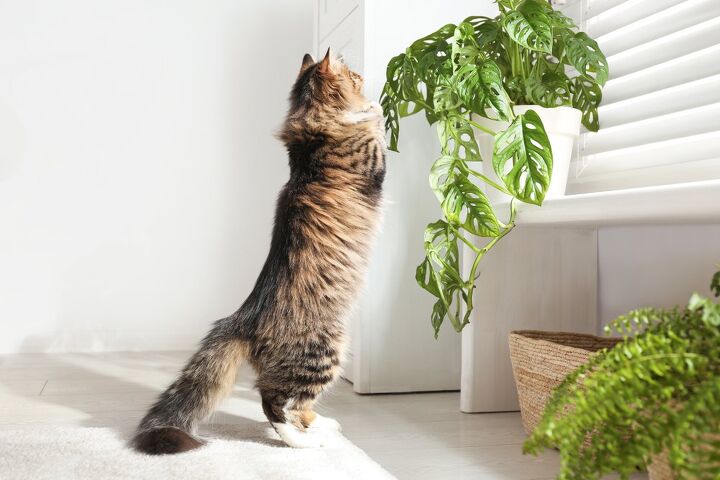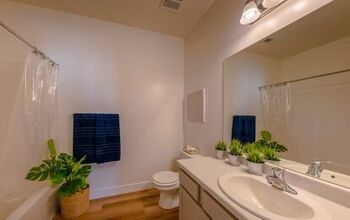What Are Some Houseplants That Are Safe For Cats?

Houseplants add as much charm to your house as your pets do. That said, you have to be careful which houseplants you choose when you have cats. Some plants are toxic to animals, even if they don’t harm humans. So, what are some houseplants that are safe for cats?
Houseplants that are safe for cats include African violets, calatheas, Boston ferns, and string of hearts. Ponytail palms, baby tears, and spider plants are easy to take care of indoors and won’t harm your felines. Never plant oleander, mums, aloe, and sago palms indoors as they contain chemicals that are toxic to cats.
Most of the safest houseplants for cats are low-maintenance and require little water. Follow along as we highlight houseplants that are safe for cats so you don’t have to wonder when you visit the garden center.
What Unique Plants Are Safe For Cats?
1. African Violet
You may be used to seeing African violets in flower beds, but they make great houseplants. Your cats may be fascinated by the colorful flowers, but they won’t get hurt if they eat them. That said, you should keep them away from your cats, so they don’t damage the beautiful flowers.
African violets don’t take up much space, as they typically only grow to be 8 inches. However, they can span up to 16 inches across, so you may need to move them to bigger pots after a while. Look no further than African violets if you want a low-maintenance houseplant that won’t hurt your cute kittens.
2. Calathea
Calathea is the perfect cat-friendly houseplant if your home doesn’t get a lot of sunlight. It thrives in shade, and in most cases, you only need to water a calathea once per week. If your house stays at least 65 degrees Fahrenheit, it should be easy for your calathea to grow.
Direct sunlight can quickly kill a calathea, so make sure to keep it away from windows. While it isn't a large plant, a calathea can grow up to two feet. Make sure to move your calathea to a new pot once it gets bigger, so the roots have plenty of room.
3. Boston Fern
You may mostly see a Boston fern on shaded porches, but it is a great houseplant as well. This has a lot to do with how low-maintenance it is, especially when it comes to light. It only requires medium light exposure, so it will do well in nearly any room in your house.
That said, you must use a grow light of some sort if you put your Boston fern in a room with no windows. Safe for cats and children, you don’t have to worry even if your cat nibbles on the leaves. Boston ferns can live for several years if you keep the soil moist and prune them in spring and summer.
4. String Of Hearts
String of hearts may be tempting for your cats to play with, but this plant won’t hurt them. A beautiful hanging plant, this unique plant works just as well indoors as it does outdoors. Find a window that gets plenty of sunlight and put your string of hearts in front of it.
That said, overly direct sunlight can prove too much for a string of hearts, depending on how close the plant is to the window. I have had the best luck putting a string of hearts in the kitchen across from the window. Make sure to mist the leaves every once in a while to remove dust and let some water drip into the soil.
5. Ponytail Palm
A ponytail palm is among the best succulent to keep in your house if you have cats or children. Make sure to put your ponytail palm in a shallow pot. Deep pots aren’t ideal for this plants, and the roots will never grow deep enough.
Ponytail palm does best when you fertilize it twice per year. Fertilize it once in early spring and once in mid-to-late summer for the best results. However, you can skip the summer fertilization if your ponytail palm is mature and doing well.
6. Baby Tears
Not all hanging plants are safe for cats, but baby tears is. Whether you put them in a pot or hang them in your kitchen, baby tears can add character to your home. Ideally, you should put baby tears in a room with some artificial lights if your home doesn’t get enough sunlight.
That said, direct sunlight can hurt baby tears. Make sure to fertilize the plant during spring for optimal growth. Keep the soil moist and the plant can grow up to 12” sooner than you’d typically expect.
7. Spider Plant
Spider plants are instantly recognizable. The only thing you must worry about if you have a spider plant and a cat is that the cat will want to smack the leaves. Otherwise, spider plants aren’t toxic to cats, so you don’t need to worry about that.
As well, a spider plant is low maintenance. You only need to water it once per week, unless the soil becomes dry. That said, it’s a good idea to check the soil for moisture each day. After all, it’s hard to revive a spider plant once it starts to go downhill.
8. Orchid
Orchids are among the safest houseplants for cats. Specifically, a moth orchid is one of the easiest orchids to grow indoors. The unique appearance of a moth orchid, with its pink flowers, can add a splash of vibrant color to your home.
You can find moth orchids at most plant nurseries, and they are easy to take care of. Put your moth orchid near an east-facing window to ensure it gets sunlight and warmth. Ideally, you should make sure your home stays above 60 degrees Fahrenheit, or else the orchid may wilt.
9. Bird’s Nest Fern
Nearly every fern makes a great houseplant, and that includes the bird’s nest fern. Safe for cats, the bird’s nest fern is easy to take care of, as long as you choose a pot and soil that drains well.
The worst thing you can do to a bird’s nest fern is oversaturate it. While it loves high humidity, soaking the soil will quickly weaken and kill a bird’s nest fern. Check the top inch of soil each day to make sure it isn’t too dry and spritz it with a spray bottle if it is.
10. Zebra Plant
Named because of its striped leaves, a zebra plant is hardy and poses no threat to your cute cats. While it is durable, it is sensitive to excessive light. Because of that, you must find a partially shaded area in your house to keep your zebra plant.
A Zebra plant does best when the soil stays consistently moist. Many homeowners simply saturate the soil once per week and give it a spritz whenever the soil becomes dry. Even though it's non-toxic, you may want to keep your zebra plants out of your cat’s reach. The leaves can be tempting to play with, and we all know cats can be mischievous.
11. Golden Polypody
Yet another fern, the golden polypody is a simple houseplant that’s safe for cats. It doesn’t require direct light, so you don’t have to worry about keeping it by the window. It’s easy to take care of as long as you keep the soil moist without oversaturating it.
Golden polypody is native to tropical climates, so it’s important to make sure your house isn’t too dry. Keep your home’s humidity level at around 60% to 70% if you have several types of ferns to ensure they grow well.
What Houseplants Are Toxic To Cats?
Mums, aloe, and sago palms are among the most toxic houseplants for cats. Unfortunately, many of the houseplants that are toxic to cats are also beautiful. Homeowners often want these plants to add color to their homes, but it can be a mistake.
For example, mums are beautiful, but they contain pyrethrin. Pyrethrin and sesquiterpene lactone are harmful to cats, dogs, and small children. Even adults can experience skin irritation from exposure to mums. The most toxic plants to cats include:
- Philodendrons
- Sago Palm
- Aloe
- Mums
- Oleander
Summing It Up
The safest houseplants for cats are zebra plants, African violets, calatheas, and Boston ferns. Other plants, like ponytail palms, string of hearts, orchids, and bird’s nest ferns are beautiful and non-toxic. Don’t keep plants like aloe, mums, and oleander in your house if you have a cat and dog.
Related Guides

Nick Durante is a professional writer with a primary focus on home improvement. When he is not writing about home improvement or taking on projects around the house, he likes to read and create art. He is always looking towards the newest trends in home improvement.
More by Nick Durante



























